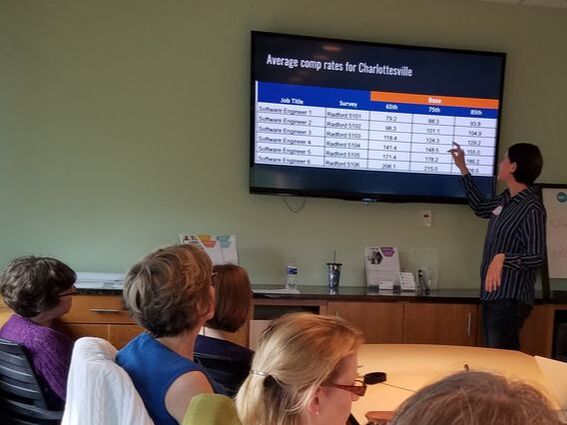 At a recent CWIT meetup, we were lucky to have Jess Mink, Director of Engineering at Auth0, talk about performance and compensation in the tech industry. She highlighted the importance of transparency in the process for both managers and employees. Whether your company is big or small, Jess’s insights about using career ladders and salary bands are helpful for anyone thinking about compensation and inspiring a team's best performance. Creating a level ground allows reviews and promotions to be based on clear expectations and performance metrics. How to give great feedback. As managers, we don’t want to be vague and unhelpful. And as employees we fundamentally want to know where we stand. We want feedback that’s clear, actionable, and has consistent standards across individuals and managers. Career ladders are one way of accomplishing this. A career ladder is a list of behaviors and outcomes that is organized thematically and by level. The goals of using a career ladder include:
How can you avoid being that jerk? We’ve already discussed how to build a shared understanding of performance. Now we’ve just got to map it to actual dollar amounts. Set levels of salary for each job description based on research of similar jobs for your local market. Ask HR for these amounts so you have a good point of reference. Key points:
Put it all together. Once you have a better understanding of these resources, put them to good use.
My company doesn’t have a ladder. Here are some steps to help your company create its own career ladder.
What makes a good career ladder? In Jess’ experience, a successful career ladder meets these guidelines:
Hack your corporate culture. The bonus of a career ladder is that it can be the single biggest influence you have on company culture. While you’re building out performance descriptions for each level, you can include requirements like, “Does not condescend to others or give the impression they think other people are less capable than they are. Defaults to assuming that other people’s knowledge is advanced and is reasonable…” or “Hires and retains a diverse team…” Help create the corporate culture you want to see. Summary by Trae Turner. This article includes excerpts from Jess Mink’s presentation, “Let’s talk about money.” View her complete slides.
|
Our MissionCharlottesville Women in Tech (CWIT) is an organization for emerging and established professionals that provides human connections and resources for women and girls interested in or associated with technology. Our vision is to bridge the gender gap in tech by providing a safe and welcoming environment for women and girls to connect, learn and collaborate in Charlottesville.
|
Join Us
Membership is free!
Stay connected with the community and learn about the latest events and jobs postings.
|
Contact UsQuestions? Ideas to share? Want to become a CWIT sponsor? Want to volunteer?
Drop the Board an email.
|



